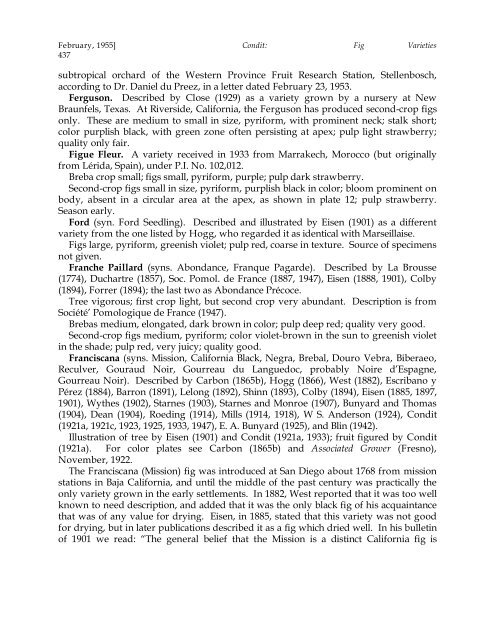Fig Varieties: A Monograph - uri=ucce.ucdavis
Fig Varieties: A Monograph - uri=ucce.ucdavis
Fig Varieties: A Monograph - uri=ucce.ucdavis
You also want an ePaper? Increase the reach of your titles
YUMPU automatically turns print PDFs into web optimized ePapers that Google loves.
February, 1955] Condit: <strong>Fig</strong> <strong>Varieties</strong><br />
437<br />
subtropical orchard of the Western Province Fruit Research Station, Stellenbosch,<br />
according to Dr. Daniel du Preez, in a letter dated February 23, 1953.<br />
Ferguson. Described by Close (1929) as a variety grown by a nursery at New<br />
Braunfels, Texas. At Riverside, California, the Ferguson has produced second-crop figs<br />
only. These are medium to small in size, pyriform, with prominent neck; stalk short;<br />
color purplish black, with green zone often persisting at apex; pulp light strawberry;<br />
quality only fair.<br />
<strong>Fig</strong>ue Fleur. A variety received in 1933 from Marrakech, Morocco (but originally<br />
from Lérida, Spain), under P.I. No. 102,012.<br />
Breba crop small; figs small, pyriform, purple; pulp dark strawberry.<br />
Second-crop figs small in size, pyriform, purplish black in color; bloom prominent on<br />
body, absent in a circular area at the apex, as shown in plate 12; pulp strawberry.<br />
Season early.<br />
Ford (syn. Ford Seedling). Described and illustrated by Eisen (1901) as a different<br />
variety from the one listed by Hogg, who regarded it as identical with Marseillaise.<br />
<strong>Fig</strong>s large, pyriform, greenish violet; pulp red, coarse in texture. Source of specimens<br />
not given.<br />
Franche Paillard (syns. Abondance, Franque Pagarde). Described by La Brousse<br />
(1774), Duchartre (1857), Soc. Pomol. de France (1887, 1947), Eisen (1888, 1901), Colby<br />
(1894), Forrer (1894); the last two as Abondance Précoce.<br />
Tree vigorous; first crop light, but second crop very abundant. Description is from<br />
Société’ Pomologique de France (1947).<br />
Brebas medium, elongated, dark brown in color; pulp deep red; quality very good.<br />
Second-crop figs medium, pyriform; color violet-brown in the sun to greenish violet<br />
in the shade; pulp red, very juicy; quality good.<br />
Franciscana (syns. Mission, California Black, Negra, Brebal, Douro Vebra, Biberaeo,<br />
Reculver, Gouraud Noir, Gourreau du Languedoc, probably Noire d’Espagne,<br />
Gourreau Noir). Described by Carbon (1865b), Hogg (1866), West (1882), Escribano y<br />
Pérez (1884), Barron (1891), Lelong (1892), Shinn (1893), Colby (1894), Eisen (1885, 1897,<br />
1901), Wythes (1902), Starnes (1903), Starnes and Monroe (1907), Bunyard and Thomas<br />
(1904), Dean (1904), Roeding (1914), Mills (1914, 1918), W S. Anderson (1924), Condit<br />
(1921a, 1921c, 1923, 1925, 1933, 1947), E. A. Bunyard (1925), and Blin (1942).<br />
Illustration of tree by Eisen (1901) and Condit (1921a, 1933); fruit figured by Condit<br />
(1921a). For color plates see Carbon (1865b) and Associated Grower (Fresno),<br />
November, 1922.<br />
The Franciscana (Mission) fig was introduced at San Diego about 1768 from mission<br />
stations in Baja California, and until the middle of the past century was practically the<br />
only variety grown in the early settlements. In 1882, West reported that it was too well<br />
known to need description, and added that it was the only black fig of his acquaintance<br />
that was of any value for drying. Eisen, in 1885, stated that this variety was not good<br />
for drying, but in later publications described it as a fig which dried well. In his bulletin<br />
of 1901 we read: “The general belief that the Mission is a distinct California fig is
















![Fig Trees in North Carolina [Archive] - IDigMyGarden ... - Figs 4 Fun](https://img.yumpu.com/26905320/1/190x245/fig-trees-in-north-carolina-archive-idigmygarden-figs-4-fun.jpg?quality=85)